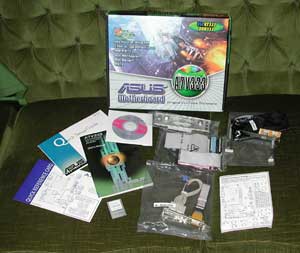|
|
Advertisement:
|
|
Asus A7V333 Review |
|
Join the community - in the OCAU Forums!
|
In the Box, Overclocking and Conclusions
In the Box
ASUS are not known for skimping on the bundled package and this motherboard is no exception.

An extra backplate is provided with 2 USB2.0 ports and the game port (as the nonstandard ATX backplate has USB and audio in place of the game port). Another spare backplate has both large and a small FireWire ports. To fit this board's nonstandard ATX connector area into your case a cut-out backing plate is also provided. Documentation is excellent with a full manual, a quick-start guide, a quick-reference card and even a layout/settings diagram which you can stick to a handy spot in your case. This will stop you having to dig up your manual every time you need to check a dipswitch, jumper setting or connector orientation. A CD full of drivers and some cables (1 floppy, 1 udma66) are standard but the metal "Powered by ASUS" case badge is a nice inclusion. Curiously there's no extra software included. I'm used to seeing an antivirus program and perhaps some disk utilities, but the Asus comes only with their Asus PC Probe which I believe is inferior to Motherboard Monitor, which is also free.
Overclocking
Not having an unlocked AthlonXP CPU does limit just how far I can stress motherboards. I do have an AGOIA AthlonXP 1600+, which afficionados will recognise as one of the more overclockable SocketA chips at the moment. Indeed, even without unlocking I could run this CPU on the A7V333 at 162MHz FSB - completing 3DMark2001SE runs without error. Dissapointingly, Win2K would not finish booting at 166MHz FSB. I say dissapointing because this CPU - indeed, all components in this testbed - carried Soltek's SL-75DRV5 to 166MHz FSB with partial stability. It could run Folding@Home for days on end, but anything involving 3D graphics were beyond it. I suspect therefore that 166MHz is slightly beyond the abilities of this CPU - but it must be noted that the Soltek seems to be a better overclocker than the Asus. Early examples of the A7V333 used the KT333CD North Bridge which is apparently not as overclockable as the later CE revision - but popping the tall heatsink off the North Bridge on this particular board, as well as hacking a chunk out of my finger, revealed the CE revision North Bridge.
Whither KT400?
In terms of the KT333 - you already know what I'm going to say here. You know because, not only is it what I said in the Soltek review, it's what you've read in every one of the other 5 million KT333 motherboard reviews you've read in the last 3 months or so. KT333 is good - there's no denying that - but it's not spectacularly better than KT266A. This is good news, though. It means if you've already got a DDR SocketA motherboard there's little reason to upgrade. If you haven't, then you can consider KT266A and KT333 boards pretty much equally. This seems likely to carry over to KT400 also, presuming the CPU FSB stays at 266MHz as we assume it will. 400MHz memory support is unlikely to be any more exciting than 333MHz was over 266MHz, with the CPU's FSB remaining the bottleneck. KT400 boards of course will bring other features - SerialATA and AGP 8X at least, but again I'm wondering how much real world difference we'll see from those. ATA-100 is not being stressed by current HDD's. AGP 4X is coping just fine too. So again, it seems likely that KT266A, KT333 and KT400 boards will be considered not so much in terms of sheer speed or go-faster bits, but in terms of extra features.
Conclusions
The Asus A7V333, with RAID, FireWire and USB2.0 has genuinely "extra" features. If you need them, the A7V333 is a sensible choice - underneath the extra features is a very good motherboard. If you don't, then you'd be paying a premium for bits you don't need. Such is the problem with feature-packing a board: you raise the price and limit the market that the board appeals to. Given Asus's strong following to date though, I'm not surprised to find that this board has been a popular choice among our forum-goers.
Thanks to Altech Computers for providing the review unit!
|
|
Advertisement:
All original content copyright James Rolfe.
All rights reserved. No reproduction allowed without written permission.
Interested in advertising on OCAU? Contact us for info.
|

|


